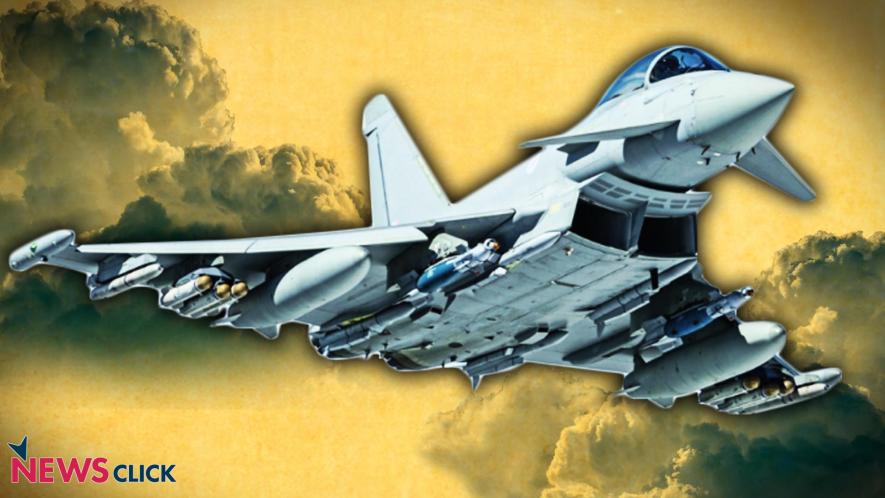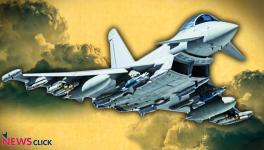Rafale: Weak Justifications, More Suspicion and a Bombshell

A flurry of media interviews by Raksha Mantri (RM) herself and by top ranking Indian Air Force officers, including the Air Chief, pertaining to the Rafale deal, have only made matters worse. The statements are full of contradictions, raise more questions than provide answers, and fuel more suspicion. These worthies end up tying themselves in knots, compelled to rationalise bad decisions which they had no part in making.
As if this were not bad enough, former French President Francois Hollande, during whose tenure the Narendra Modi government struck the Rafale government-to-government deal, has now dropped the proverbial bombshell. He has openly stated that Reliance Aerospace, led by Anil Ambani, had been pre-selected by the Indian government for taking up Rafale offsets, and that France had no role in the matter, flatly contradicting repeated assertions made by the RM and other government spokespersons in India. French company Dassault Aviation’s subsequent counter-assertion that they had selected Reliance carries little credibility, since Dassault has vested interests in the deal which it would not want to jeopardise by going against the government position.
Also Watch: Hollande’s Rafale Revelations: Indian Government's Game Plan Backfired
Notwithstanding these latest developments, the main points made by the RM and the IAF brass require to be clarified, so that issues of vital national interest are not lost sight of in the din of sensationalism and a cloud of confusion.
The main issues raised are: (a) by the IAF chief, that the Rafale is a very good fighter, badly needed by the IAF, and pleading that the deal not be jeopardised by the present furore; (b) by the RM and the IAF Chief, that restricting the order to 36 fighters (2 squadrons) from the originally tendered 126 was justified for several reasons; (c) that the MMRCA tender for 126 Rafales had to be cancelled in favour of an inter-governmental deal because public sector Hindustan Aeronautics Ltd (HAL) “did not have the capacity to make Rafales” in India, and also that negotiations between Dassault and HAL collapsed over price and refusal by Dassault to guarantee HAL-made fighters due to quality issues; (d) that the Indian government had no role in choosing Reliance as an offset partner, a decision left to the foreign commercial entity, the OEM Dassault, as in other offset deals.
All these assertions are incorrect if not misleading, and conceal more than they reveal.
Choice of Rafale
The IAF Chief need not be worried! During this entire Rafale controversy, nobody, repeat nobody, including these columns, has questioned the quality or choice of the Rafale. An interesting feature of questionable defence acquisitions is that illegal gratifications are rarely any reflection of the product’s quality, kickbacks or quid pro quos may be demanded simply to sign on the dotted line! Witness the Bofors gun, an undoubted star of the Kargil conflict.
Here the question that still remains, which the IAF Chief did not answer, is why the IAF’s choice of fighter after extensive field trials was retained but not the number of aircraft? Was the IAF wrong about its carefully worked out requirement of 126 (7 squadrons)? Who decided that 36 will do? And if so, why was a fresh MRCA tender issued for 110 fighters, forcing India to go through the arduous process all over again, causing further delay in the IAF’s dire need for new fighters? It is shameful that the government is seeking to ward off public criticism by hiding behind the IAF.
Why only 36 aircraft?
The IAF Chief and the RM sought to justify the restricted order of 36 fighters by citing ‘emergency’ requirement and quick inter-governmental processing, giving examples of similar earlier acquisitions of MiG-29s and Mirage-2000s. Again the facts are at variance. India did indeed order these aircraft as an urgent need prompted by Pakistan’s acquisition of F-16s from the US. But after the initial order of 50, India acquired a total of 78 MiG-29s, including naval variants. Similarly, the order for Mirage-2000 was for 40 fighters, including four two-seater trainers. However, the IAF had projected a requirement of 150 fighters with licensed production by HAL, an order whittled down to 40 by the usual combination of bureaucratic dilly-dallying and financial penny-wise-pound-foolish decision-making. After the Mirage’s huge success during Kargil, India even sought to acquire, but delayed its decision for so long that Dassault had meanwhile closed its production line!
In fact, due to such flawed decision-making, especially by the civilian bureaucracy, also contributed to by IAF’s request and unexplained changes of mind and lack of strategic planning, the IAF is today hampered by a menagerie of aircraft types, handfuls of MiG-23/27s, Jaguars, MiG-29s, Mirage-2000s, and now wants to add to the logistical nightmare by adding a mere 36 Rafales! The IAF may need divine assistance if conflict breaks out. The original MMRCA decision to buy 126 Rafales would have gone a long way to ameliorate this problem, with an IAF fleet comprising sizeable numbers of Tejas/LCA, Sukhoi-30s and Rafales. But no!
The RM also justified the limited acquisition by arguing that buying more all at once would strain infrastructure and logistics. What a strange argument, coming from a Minister no less! No Air force buys, and no manufacturer supplies hundreds of aircraft at one go, and logistics and infrastructure are always readied to keep pace. In any case, even the ‘emergency’ Rafales are arriving at a leisurely pace over the next three years, while Dassault had supplied and the IAF was able to induct 40 Mirages almost within a single year, that too several decades ago!
HAL capability
The most astounding claim by the Raksha Mantri was that HAL does not have the capacity to make Rafales! Is this the same HAL which undertook a major upgrade of Dassault Mirage-2000s, or manufactured under license 200 upgraded RD-33 engines for MiG-29s, or is manufacturing advanced Sukhoi-30 MkI from basic raw materials, or is making almost 100 Hawk-132 Advanced Jet Trainers under license from BAe, or has set up a completely new helicopter plant near Bangalore where it will make hundreds of choppers?
Recently retired HAL CMD Suvarna Raju has claimed that full license-manufacture details had been worked out with Dassault, and that HAL was fully prepared to stand guarantee for aircraft made by it. He agreed that HAL prices were high. However, this could have been negotiated, with the Government playing a forceful role and pumping in finances for necessary infrastructure in the interests of self-reliance.
Importantly, the IAF and HAL have long been at loggerheads over delivery schedules, quality and cost. HAL must take its considerable share of responsibility for this state of affairs and its poor work culture. The IAF, too, must overcome the persistent preference of many of its brass for imported equipment compared with indigenous HAL-made hardware, with a variety of sometimes questionable motivations. But, above all, it is the role of the Government and the political leadership, to bring to bear a strategic vision, and discipline, efficiency and work culture in its defence public sector undertakings (DPSUs) that function under the Defence Ministry and over which she has complete oversight. This accountability for DPSUs is completely missing, including but not only, under the present Government. It will simply not do for the RM to say that HAL and Dassault were unable to agree on manufacturing in India, it is government’s job to bring about such an agreement.
What is even worse is that inspired leaks to sections of the press have cited reports supposedly by the US Ambassador to India and by Dassault questioning HAL’s capabilities. Ever since Independence, India has known that the US and other Western powers have done their best to prevent self-reliance in science & technology in India. It is a real shame they the same forces are now being cited to discredit our own DPSU!
Offsets & Reliance
Lastly, on offsets. The RM and other government spokespersons have frequently sought to hide behind various procedural stipulations related to defence procurement, for instance, arguing that as per rules the foreign OEMs (original equipment manufacturer) will select their own Indian partners for offsets work. All procedures are, or ought to be, subordinate to overarching strategic goals. Offsets are meant not just for keeping part of the expenditure within India, but to acquire advanced technologies and build self-reliant defence industries. This requires that offset activities and local partners are carefully selected with a strategic vision for expanding the technological base in identified sectors. This in turn requires a pro-active government role, not leaving it to commercial agreements between overseas and Indian partners.
The RM’s defence that choice of partner and offset task had been left to Dassault which picked Reliance for the purpose, defies common sense. Would Dassault or any other OEM, who have supposedly found even HAL wanting, choose an Indian partner like Reliance, with a poor financial record and no experience in aviation or even other manufacture? And even if they had done so for whatever reasons, should the Government have stood by silently instead of insisting on genuine technology transfer of some kind? It should also be realised that any foreign defence manufacturer would prefer to have a small, inexperienced Indian partner rather than HAL since the latter would actually absorb advanced technologies and potentially deprive the OEM of future markets, while the former could only do screw-driver assembly and be no threat whatsoever.
All the actions by the Government on the Rafale deal, and all its attempts at post facto rationalisation, show it in a poor light, with no strategic vision for the defence sector, for defence manufacturing in India, and for self-reliant development. The Rafale deal is a hopeless mess and the longer the imbroglio drags on, the worse it will get, exposing India’s soft underbelly for all the world to see.
Get the latest reports & analysis with people's perspective on Protests, movements & deep analytical videos, discussions of the current affairs in your Telegram app. Subscribe to NewsClick's Telegram channel & get Real-Time updates on stories, as they get published on our website.
























